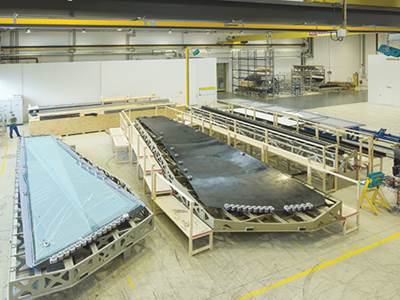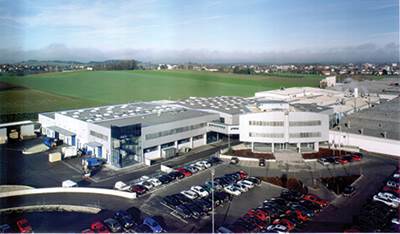FACC timeline: Engineer-centric evolution
A short history of aerospace tier supplier FACC AG (Ried Im Innkreis, Austria).
FACC (Ried im Innkreis, Austria) has always been an engineering-based company. Its CEO, Walter Stephan, started out as head of R&D at ski manufacturer Fischer GmbH (Ried im Innkreis, Austria). When the company faced having to lay off half of its 100 R&D engineers in 1981, Stephan suggested, instead, that the company should design parts for other industries. That same year, his group won a worldwide competition to develop the Airbus A310 crossbeam floor support (floor strut) using carbon fiber/epoxy prepreg. “We completed development in six months,” Stephan recalled, “which was impressive because the structure included 75 parts and had 35 different configurations due to changes in loads, depending on the location in the fuselage.”
In 1986, FACC became a separate division, with 27 employees and annual revenue of $1.5 million USD (€1.2 million). That same year, it won a contract from Rohr Inc. (now United Technologies Corp., Hartford, Conn.) to make doorframes for the McDonnell Douglas (St. Louis, Mo.) MD-80 commercial passenger jet. The following year, FACC Plant 1 was built, and the company was awarded the composite flap hinge fairings and sidewall panels contract (previously aluminum) for the McDonnell Douglas MD-11.
When it was spun off as an independent company in 1989, FACC AG had grown to 102 employees and $7.5 million USD (€6 million) in annual revenue and had begun production of overhead luggage bins and ceiling panels for the Airbus (Toulouse, France) A320/A321 single-aisle family. Its first complete passenger cabin was for the MD-95, which was renamed the B717 after The Boeing Co. (Chicago, Ill.) acquired McDonnell Douglas in 1996.
FACC’s engine and nacelle structures business began in 1994 with the engine nozzle for the CFM56-5C engine on the Airbus A340-200/300 family and expanded in 1996 to fan cowls for the CFM-56 5A and 5B. Stephan recounted, “That was a carbon fiber sandwich construction that we won because the previous supplier could not meet production targets.”
In 1999, Plant 2 was built in nearby Ort im Innkreis. This campus now hosts production Plants 2 and 3 (totaling 18,300 m2/194,000 ft2) as well as FACC’s Technology Center and adjacent Composite Lab and Test Center (Plant 5), added in 2012 and capable of airworthiness certification testing for large aerostructures. This facility centralizes R&D and houses 500 engineers from FACC’s three product divisions. FACC already has committed to $67.6 million (€54 million) in R&D as part of the extensive investment outlined in its Vision 2020 strategy. The 21,000m2/226,000-ft2 Plant 4, which now houses engine cowl and nacelle manufacturing was added in nearby Reichersberg in 2007.
In 2009, Xi’an Aircraft Industry (Group) Co. Ltd. (XAC, Xi’an, China), a subsidiary of Aviation Industry Corp. of China (AVIC, Beijing, China), became FACC’s majority shareholder. Walter Stephan remained CEO and FACC’s Austrian operations expanded. But FACC has since given greater emphasis to its global positioning. In 2011, FACC was awarded the complete interior contract for Commercial Aircraft Co. of China’s (COMAC) C919 single-aisle jetliner. That same year, it announced its joint venture with Aerocomposit, a subsidiary of Moscow-based United Aircraft Corp., to develop and produce composite components for Superjet International’s (Venice Italy) Superjet SSJ100, the Irkut (Moscow, Russia) MS-21 and other Russian-made aircraft.
In 2012, FACC commissioned a new 16,000m2 (172,000-ft2) production facility in Zhenjiang, China (250 km/155 miles northeast of Shanghai) to gain a foothold in a regional market that is estimated to need more than 4,300 aircraft in the next 20 years. Here, FACC offers not only local production to support aircraft OEMs’ offset commitments for aircraft purchases, but also what it terms “powerful synergies,” including XAC’s experience in producing wing and empennage (vertical tail) structures.
This short article is a sidebar to a feature article titled "FACC AG: Aerocomposites Powerhouse." To read the main article, click on its title under "Editor's Picks," at top right.
Related Content
Materials & Processes: Composites fibers and resins
Compared to legacy materials like steel, aluminum, iron and titanium, composites are still coming of age, and only just now are being better understood by design and manufacturing engineers. However, composites’ physical properties — combined with unbeatable light weight — make them undeniably attractive.
Read MorePlant tour: Joby Aviation, Marina, Calif., U.S.
As the advanced air mobility market begins to take shape, market leader Joby Aviation works to industrialize composites manufacturing for its first-generation, composites-intensive, all-electric air taxi.
Read MoreMaterials & Processes: Fabrication methods
There are numerous methods for fabricating composite components. Selection of a method for a particular part, therefore, will depend on the materials, the part design and end-use or application. Here's a guide to selection.
Read MoreThe state of recycled carbon fiber
As the need for carbon fiber rises, can recycling fill the gap?
Read MoreRead Next
FACC: Aerospace infusion pioneer
Although it’s “new” to aerospace, liquid resin infusion has been the focus of R&D at FACC (Ried im Innkreis) since 2001. “The issue,” said FACC’s aerostructures product development director Hermann Filsegger, “is in getting 100 percent wetout with no voids in a large part with this much complexity.” That’s not, by any means, an easy task.
Read MoreFACC AG: Aerocomposites Powerhouse
This pragmatic Austria-based innovator is pursuing lofty goals in an aerocomposites future full of opportunity.
Read MoreFACC AG: Aerocomposites Powerhouse
This pragmatic Austria-based innovator is pursuing lofty goals in an aerocomposites future full of opportunity.
Read More
























